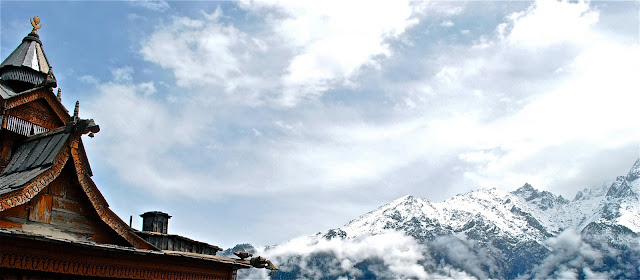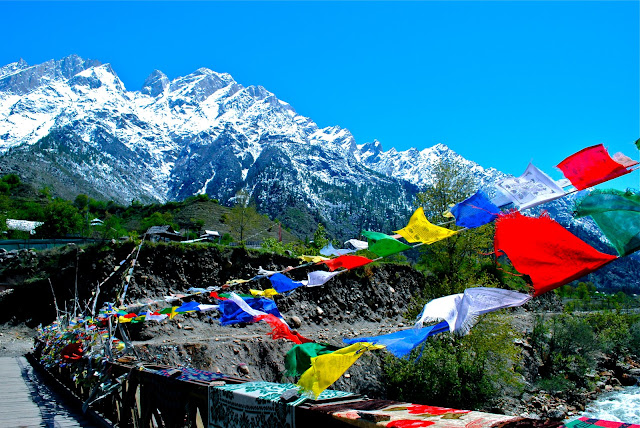Along the Tibetan border, touched
by three mountain ranges - Zanskar,
Greater Himalayas and Dhauladhar
- lay the Kinnaur Valley, famous for its sight and the particular mix of custom
and culture.
Open to the outsiders only on 1986,
the region is still one of the less visited in India and thanks for that, it preserved
its charm and authenticity.
From Shimla, taking the old
Hindustan-Tibet road (built by the British on 1850) you reach Kalpa and Sangla,
a “must” of the valley.
The trip is long and the highway
one of the deadliest of the world, but this is what you have to experience to
reach a place of intense splendor.
On the way to Kalpa you will cross
the typical Indian city on the road,
squalid and noisy, and the working in progress of hydroelectric projects. The picture is definitely horrible and the
tears of the mountain spill into the Satluj River, painting it in gray color.
It seems that the sun decided to turn away its glance, therefore the lack of
light and the perpetual greyness give you a feeling of massive destruction by
the hand of human. But I don’t want to put you down so when the dam is far
behind you, and the road start to climb toward Rekong Peo, the nature returns
to be the undisputed queen of the trip.
Almost at 3000m of altitude you
reach your destination, a small village that let you forget about the
exhausting trip. Here the view is impressive and mountain’s peaks are above
6000m; between them, the Kinnaur Kailash
Mountain is particularly important among the Hindu religion: its lingam shape (symbol related to Lord Shiva) and the homonym mountain in
Tibet, make this a destination of extreme pilgrimage and arduous trekking.
Because of the thousand years-old coexistence
between Tibetan Buddhism and Hinduism – as much as some local had placed their
faith in both religions – and the balance of Indian-Tibetan-Chinese tradition,
the atmosphere is much distinctive and the architecture unique in its gender.
The endless Buddhist flags hanged
on the top of the stupa and the
wooden roof of the Hindu temples, give to the place an atmosphere of peace and
harmony.
To head toward Sangla, you have to
get again into the Hindustan-Tibet road, but
don’t worry it is a small stretch and coming close to Sangla you enjoy again the marvelous landscape. The scenario is typical of Himalayan range, characterized by lake, rivers, snowy mountains, forests, orchards and flowered grass.
don’t worry it is a small stretch and coming close to Sangla you enjoy again the marvelous landscape. The scenario is typical of Himalayan range, characterized by lake, rivers, snowy mountains, forests, orchards and flowered grass.
You can take nice walks in the
woods and along the river but the old town on top of the hill will give you the
feeling to be in another age. Step after step you walk away from the
surrounding reality to a world made of stones, pagodas, temples carved into
wood and barns full of goats. The blessed silence and the stillness have a lot
to tell you…
If you are in the right season and full of luck, an abundant snowfall will make the excursion much more surreal and magical.
If you are in the right season and full of luck, an abundant snowfall will make the excursion much more surreal and magical.
According to the ancient mythology,
gods populated the valley and the people of Kinnaur were known as Kinners, the
halfway between men and gods.
For sure, this valley has an
intense spirituality, found in its people and the astonishing nature. Through
vividness and magnificence of the landscape, you experience a compose and
dominant perfection: call it Lord Shiva, Mother Nature or altitude sickness but
this perception of greatness and splendor will not leave you throughout the
whole journey.
It is an itinerary at world’s end
where the majestic nature and the precious quite are only legitimate
sovereigns.
Info
trekking:
hpkinnaur.nic.in
indiatrekkings.com/kinnerkailashtrek.html
project-himalaya.com/jindiatrek-kinnaur-kailash.html
indiatrekkings.com/kinnerkailashtrek.html
project-himalaya.com/jindiatrek-kinnaur-kailash.html
all the material belongs to ©inindiaperamore.blogspot.com





